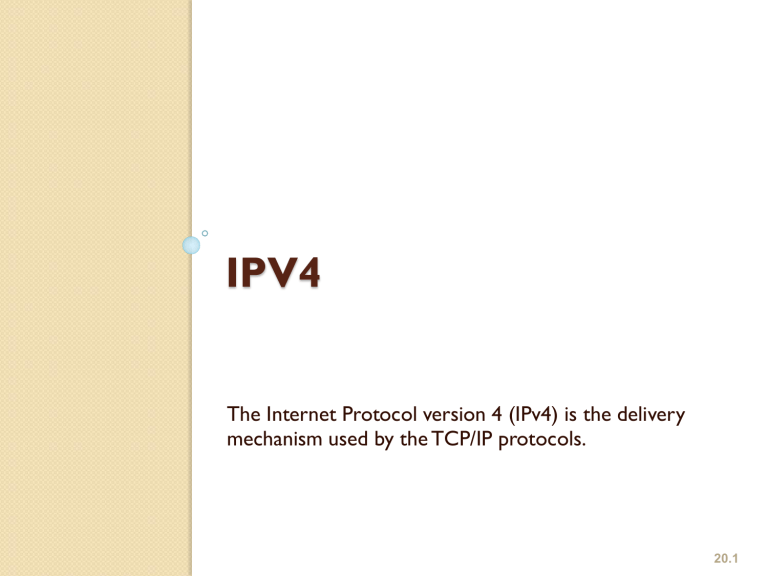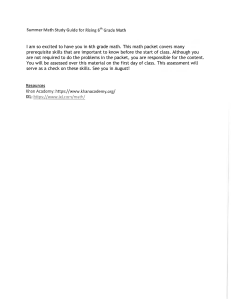
IPV4 The Internet Protocol version 4 (IPv4) is the delivery mechanism used by the TCP/IP protocols. 20.1 Position of IPv4 in TCP/IP protocol suite 20.2 IPv4 datagram format 20.3 IPv4 Header Variable length: 20-60 byte (multiple of 4) Contains routing information 20.4 IPv4 Format Version (4-bit): currently 4. Header length (4-bit): the length of the IP header in 4-byte unit. Type of Services(TOS): Total length ◦ This field was not used earlier because of the lack of standard ◦ DiffServ uses this field for differentiate packet types. ◦ to defines the total length of the datagram including the header in bytes. ◦ 16-bit number, the maximum IP size is limited to 216 bytes, or 64 Kbytes. 20.5 IPv4 Format Identification ◦ A source node gives a unique ID to each packet. ◦ Identification, Flags, Fragmentation offset fields are used for fragmentation (will be covered later) Time to Live (TTL) ◦ A packet has a limited lifetime in the network to avoid zombie packets. ◦ Designed to hold a timestamp, and decreased by each router. A packet is discarded by a router if TTL is zero. ◦ Revised to hold the maximum number of hops the packet can travel thru the network. Each router decrements it by one. Protocol ◦ ◦ ◦ ◦ ◦ ◦ To define payload protocol type 1 for ICMP 2 for IGMP 6 for TCP 17 for UDP 89 for OSPF 20.6 IPv4 Format Header checksum ◦ Refer RFC 1071 ◦ An IP header is slightly modified by each router. At least TTL field. ◦ The checksum must be re-calculated by routers which is a kind of general compuers with more than one network interface. ◦ The checksum must be efficiently calculated with no need of special hardware. Source IP address and Destination IP address Options ◦ Variable length ◦ For new protocols Padding ◦ To make the header a multiple of 32-bit words 20.7 Example 20.1 An IPv4 packet has arrived with the first 8 bits as shown: 01000010 The receiver discards the packet. Why? Solution There is an error in this packet. The 4 leftmost bits (0100) show the version, which is correct. The next 4 bits (0010) show an invalid header length (2 × 4 = 8). The minimum number of bytes in the header must be 20. The packet has been corrupted in transmission. 20.8 Example 20.2 In an IPv4 packet, the value of HLEN is 1000 in binary. How many bytes of options are being carried by this packet? Solution The HLEN value is 8, which means the total number of bytes in the header is 8 × 4, or 32 bytes. The first 20 bytes are the base header, the next 12 bytes are the options. 20.9 Example 20.3 In an IPv4 packet, the value of HLEN is 5, and the value of the total length field is 0x0028. How many bytes of data are being carried by this packet? Solution The HLEN value is 5, which means the total number of bytes in the header is 5 × 4, or 20 bytes (no options). The total length is 40 bytes, which means the packet is carrying 20 bytes of data (40 − 20). 20.10 Example 20.4 An IPv4 packet has arrived with the first few hexadecimal digits as shown. 0x45000028000100000102 . . . How many hops can this packet travel before being dropped? The data belong to what upper-layer protocol? Solution To find the time-to-live field, we skip 8 bytes. The time-to-live field is the ninth byte, which is 01. This means the packet can travel only one hop. The protocol field is the next byte (02), which means that the upper-layer protocol is IGMP. 20.11 Fragmentation A IP packet can travel through many different networks using different L2 (Data Link layers). The source node has no idea of the path and data link layer its packets will travel. MTU ◦ Each DL has its own frame format and limitation. ◦ One of such limitation is the maximum size of the frame, which is imposed by software, hardware, performance, and standards. 20.12 MTUs for some networks 20.13 Fragmentation of IP The source node usually does not fragment the packet. Instead, L4 will segment the data into a size that can fit into L3 and L2 of the source. But, there is a possibility that a packet travel thru a link whose MTU is smaller than one of the source node. ◦ Then, the packet must be fragmented to go forward the next hop. ◦ Each fragment has its own header mostly repeated from the original packet. ◦ A fragmented packet can be further fragmented into even smaller packet. ◦ Fragmented packets will be re-assembled only by the final destination. Why? 20.14 Fields for Fragmentation Identification ◦ The source host generates the unique ID Flags (3-bits) ◦ Unused bit ◦ DF bit (Don’t Fragment) 1 – force the router not to fragment the packet. If the packet length is greater than the MTU, the router will discard the packet and send an error message to the source ◦ MF bit (More Fragment) 1 – tell the destination whether or not more fragments follow Offset ◦ Unit of 8-byte (why?) ◦ Between the beginning of the packet to be fragmented and the beginning of the fragment Intelligent Router (Switch) uses these fields for efficiency. ◦ PPD (Partial Packet Discard) ◦ EPD (Early Packet Discard) 20.15 Fragmentation example 20.16 Detailed fragmentation example 20.17 Example 20.5 A packet has arrived with an M bit value of 0. Is this the first fragment, the last fragment, or a middle fragment? Do we know if the packet was fragmented? Solution If the M bit is 0, it means that there are no more fragments; the fragment is the last one. However, we cannot say if the original packet was fragmented or not. A non-fragmented packet is considered the last fragment. 20.18 Example 20.6 A packet has arrived with an M bit value of 1. Is this the first fragment, the last fragment, or a middle fragment? Do we know if the packet was fragmented? Solution If the M bit is 1, it means that there is at least one more fragment. This fragment can be the first one or a middle one, but not the last one. We don’t know if it is the first one or a middle one; we need more information (the value of the fragmentation offset). 20.19 Example 20.7 A packet has arrived with an M bit value of 1 and a fragmentation offset value of 0. Is this the first fragment, the last fragment, or a middle fragment? Solution Because the M bit is 1, it is either the first fragment or a middle one. Because the offset value is 0, it is the first fragment. 20.20 Example 20.8 A packet has arrived in which the offset value is 100. What is the number of the first byte? Do we know the number of the last byte? Solution To find the number of the first byte, we multiply the offset value by 8. This means that the first byte number is 800. We cannot determine the number of the last byte unless we know the length. 20.21 Example 20.9 A packet has arrived in which the offset value is 100, the value of HLEN is 5, and the value of the total length field is 100. What are the numbers of the first byte and the last byte? Solution The first byte number is 100 × 8 = 800. The total length is 100 bytes, and the header length is 20 bytes (5 × 4), which means that there are 80 bytes in this datagram. If the first byte number is 800, the last byte number must be 879. 20.22 Example 20.10 Figure 20.13 shows an example of a checksum calculation for an IPv4 header without options. The header is divided into 16-bit sections. All the sections are added and the sum is complemented. The result is inserted in the checksum field. 20.23 Internet Checksum only for the header, but not for the payload ◦ Each router modifies the IP header, but not the payload. ◦ No special hardware can be used. Computationally efficient. ◦ The upper layers will check the integrity of the payload by their own schemes. ◦ The detail will be covered later. 20.24 Figure 20.13 Example of checksum calculation in IPv4 20.25




